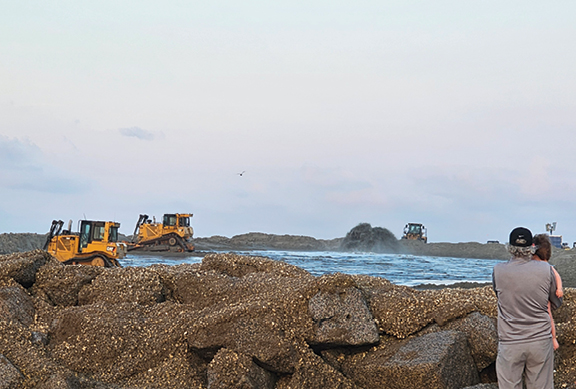Beach renourishment is a vital project to battle beach erosion
by Jenny Peterson | Current Staff Writer
Beach renourishment is the “adding of sediment onto or directly adjacent to an eroding beach.” The large construction vehicles on the beach hope to keep Folly Beach intact. This is especially important as the NOAA predicts above-normal 2024 Atlantic hurricane season.
Since 1930, Congress authorized the U.S. Army Corps of Engineers to play a role in shore protection. During the 1950s, construction began on the first 18 federal shore protection projects, most of them involving beach nourishment. The Corps has constructed 87 major shore protection projects, most on the Atlantic coastline. Projects are generally federally funded by and planned by the Army Corps of Engineers using existing sand either offshore or from other local areas.
The last time Folly Beach had a renourishment was 2018. This current $18 million renourishment is 100 percent funded by the federal government. It started in the spring and expected to end in September (a roughly six-month project) with crews working all day and night and areas of the beach are closed off as construction crews work on specific areas at a time. In July, crews were working around the area of third street East, after starting on the far West End of Folly Beach at the County Park and slowly marching east.
The Folly Current spoke with Wes Wilson, Project Manager for the U.S. Army Corps of Engineers Charleston District, about how the renourishment is going.
FOLLY CURRENT: As of July 1, 2024, how many miles and cubic yards of beach will have had renourishment? How many more miles to go?
Wes Wilson: As of June 27, 2024, 900,000 cubic yards, equivalent to 90,000 dump trucks of material, has been placed over three miles. Two miles of beach are left to renourish.
FC: In areas that are already renourished, what does the beach look like? Is someone monitoring how well it’s doing?
WW: The beach in completed areas is wider, taller and has fresh sand. The beach extends further out into the water than before and the dunes are taller, reducing the risk of storm surge to life and infrastructure behind the dunes. Quality assurance specialist from the contractor and US Army Corps of Engineers take sand samples of the renourished beach every 500 feet. These samples are sent off for testing to ensure the sand is compatible with the existing beach. The City of Folly Beach monitors the beach on an annual basis through surveys and periodic inspections.
FC: Is the target completion date still September 2024?
WW: Yes, we are still on track to complete the project by peak hurricane season.
FC: Will there be any holidays taken?
WW: The contractor will likely limit operations during the 4th of July. During this time, the sections that are closed for construction will remain closed as to not disturb the work. We do not know exactly where the contractor will be on the holiday as mechanical and weather delays can cause a section to take longer than anticipated. The best way for people to find what sections are closed is to visit our construction tracker at www.sac.usace.army.mil. The tracker is updated every morning and is the best way to find the current location of the renourishment.
FC: Is construction happening at night for heat purposes or to get the project done as soon as possible? What are some ways you are working to protect sea turtles and nests?
WW: Construction is taking place 24/7 to ensure the project is completed by peak hurricane season and to minimize the time sections are closed to the public. Sea turtle monitors working for the contractor routinely observe the beach for any sea turtles or nests. The monitors will move nests to a safe location if they are determined to be in the project’s path.
FC: Have there been any hiccups or unexpected challenges with the work so far? Or has it been easier or smoother than expected?
WW: The work is going great and has been progressing as planned. The beach is on track to be fully renourished by peak hurricane season, which is the target deadline. Dredging material from the Folly River is a much less expensive and complicated process then utilizing an offshore borrow area, which saves time and money.
How are you getting the sand from the Folly River onto the beach? What is the method of transportation?
WW: The sand is pumped through pipes from a dredge in the Folly River. The pipes run directly from the dredge onto the beach on the southern portion of Folly through the County Park. For the northern portion of Folly, the pipe is submerged offshore and booster pumps allow the sand to travel long distances. The submerged pipe runs up onto the shore and than along the beach until reaching the active construction area, where the material is deposited.
How many workers are working on the project total?
WW: Between the two contractors, Gator Dredging and Marinex Dredging, the number of workers range between 25-50. This includes workers on the beach, dredge crews, subcontractor surveyors, monitors, safety officers and more.


